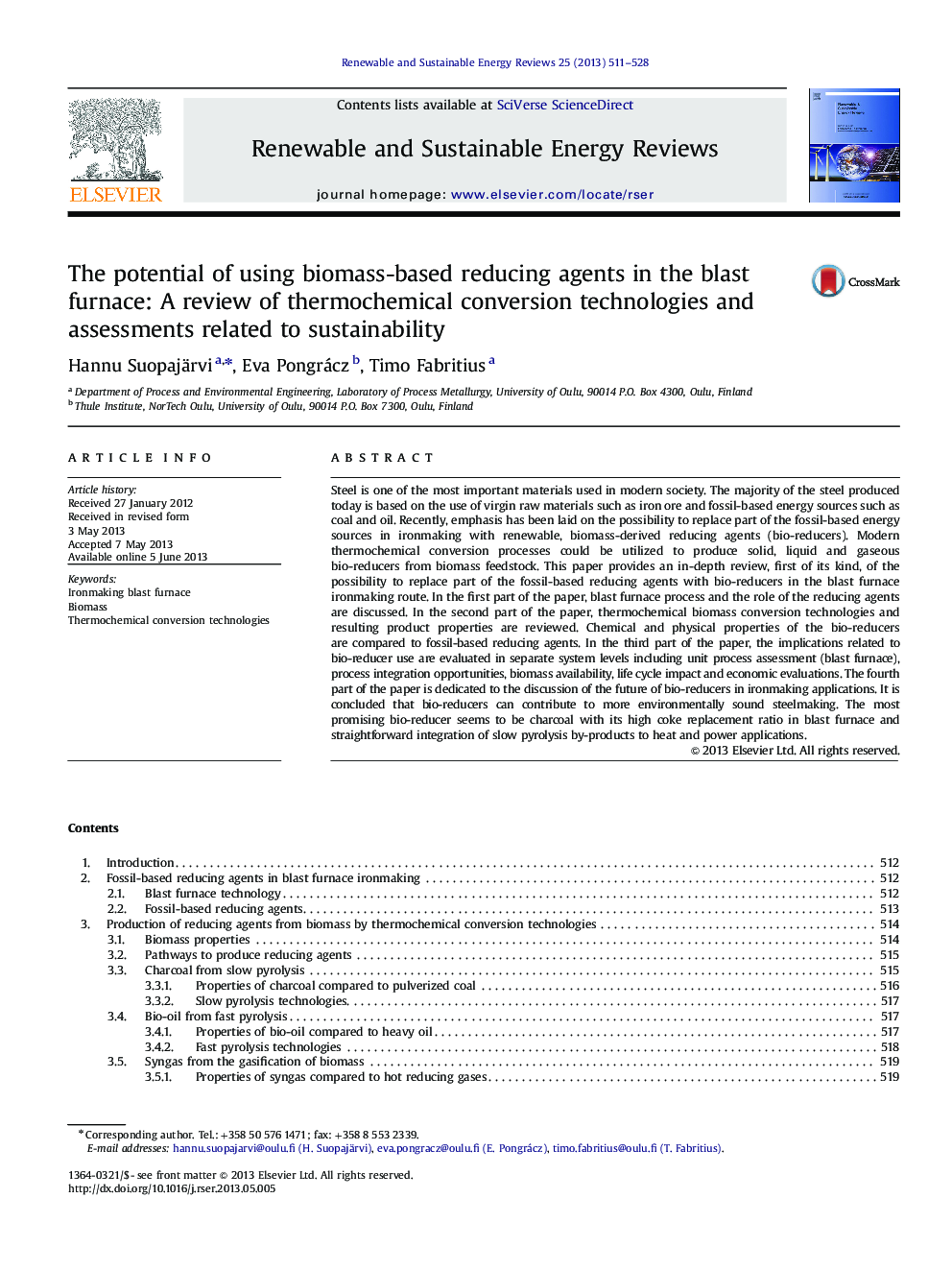| کد مقاله | کد نشریه | سال انتشار | مقاله انگلیسی | نسخه تمام متن |
|---|---|---|---|---|
| 8121724 | 1522360 | 2013 | 18 صفحه PDF | دانلود رایگان |
عنوان انگلیسی مقاله ISI
The potential of using biomass-based reducing agents in the blast furnace: A review of thermochemical conversion technologies and assessments related to sustainability
ترجمه فارسی عنوان
پتانسیل استفاده از عوامل کاهش دهنده زیست توده در کوره های انفجاری: بررسی تکنولوژی های تبدیل شیمیایی و ارزیابی مربوط به پایداری
دانلود مقاله + سفارش ترجمه
دانلود مقاله ISI انگلیسی
رایگان برای ایرانیان
کلمات کلیدی
کوره انفجار آهنی، زیست توده، تکنولوژی تبدیل شیمیایی حرارتی،
ترجمه چکیده
فولاد یکی از مهمترین مواد مورد استفاده در جامعه مدرن است. اکثریت فولاد تولید شده امروزه بر اساس استفاده از مواد خام اولیه مانند سنگ آهن و منابع انرژی فسیلی مانند ذغال سنگ و نفت است. اخیرا تاکید بر امکان جایگزینی بخشی از منابع انرژی پایه فسیلی در تولید آهن با استفاده از عوامل کاهش دهنده زیست توده قابل احتراق (زیستی) بوده است. فرایندهای تبدیل گرماسیم شیمیایی مدرن می تواند برای تولید مواد زیستی جامد، مایع و گاز از مواد زیست توده استفاده شود. این مقاله یک بررسی عمیق، ابتدا از نوع خود، امکان تعویض بخشی از عامل های کاهش دهنده فسیلی با زیستی را در کوره های تولید انفجار خط آهن می دهد. در بخش اول مقاله، روند کوره انفجار و نقش عوامل کاهش دهنده مورد بحث قرار گرفته است. در بخش دوم مقاله، فن آوری های تبدیل انرژی زیست توده گرما و شیمیایی و خصوصیات محصول محصول بررسی شده است. خواص شیمیایی و فیزیکی زیست-آبرسان ها به عوامل کاهش دهنده فسیل کمک می کند. در قسمت سوم مقاله، مفاهیم مربوط به استفاده از زیست تخریب در سیستم های جداگانه شامل ارزیابی فرآیند واحد (کوره انفجاری)، فرصت های ادغام فرآیند، دسترسی به زیست توده، تأثیر چرخه زندگی و ارزیابی اقتصادی ارزیابی می شود. بخش چهارم این مقاله به بحث درباره آینده زیستیابزارها در کاربردهای آهن سازی اختصاص یافته است. به این نتیجه می رسیم که زیست-یابنده ها می توانند در تولید فولاد سازگار با محیط زیست بیشتر کمک کنند. به نظر می رسد زود رنج آورترین زیست سازنده زغال چوب با نسبت بالای جایگزینی کک خود در کوره های انفجاری و ادغام مستقیم آن از سوی محصولات جانبی آهسته پیرولیز برای کاربردهای گرمایشی و برق است.
موضوعات مرتبط
مهندسی و علوم پایه
مهندسی انرژی
انرژی های تجدید پذیر، توسعه پایدار و محیط زیست
چکیده انگلیسی
Steel is one of the most important materials used in modern society. The majority of the steel produced today is based on the use of virgin raw materials such as iron ore and fossil-based energy sources such as coal and oil. Recently, emphasis has been laid on the possibility to replace part of the fossil-based energy sources in ironmaking with renewable, biomass-derived reducing agents (bio-reducers). Modern thermochemical conversion processes could be utilized to produce solid, liquid and gaseous bio-reducers from biomass feedstock. This paper provides an in-depth review, first of its kind, of the possibility to replace part of the fossil-based reducing agents with bio-reducers in the blast furnace ironmaking route. In the first part of the paper, blast furnace process and the role of the reducing agents are discussed. In the second part of the paper, thermochemical biomass conversion technologies and resulting product properties are reviewed. Chemical and physical properties of the bio-reducers are compared to fossil-based reducing agents. In the third part of the paper, the implications related to bio-reducer use are evaluated in separate system levels including unit process assessment (blast furnace), process integration opportunities, biomass availability, life cycle impact and economic evaluations. The fourth part of the paper is dedicated to the discussion of the future of bio-reducers in ironmaking applications. It is concluded that bio-reducers can contribute to more environmentally sound steelmaking. The most promising bio-reducer seems to be charcoal with its high coke replacement ratio in blast furnace and straightforward integration of slow pyrolysis by-products to heat and power applications.
ناشر
Database: Elsevier - ScienceDirect (ساینس دایرکت)
Journal: Renewable and Sustainable Energy Reviews - Volume 25, September 2013, Pages 511-528
Journal: Renewable and Sustainable Energy Reviews - Volume 25, September 2013, Pages 511-528
نویسندگان
Hannu Suopajärvi, Eva Pongrácz, Timo Fabritius,
